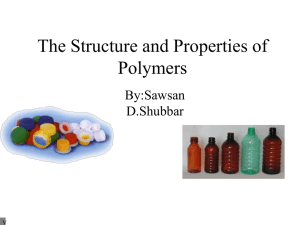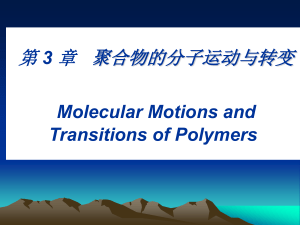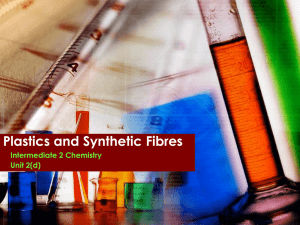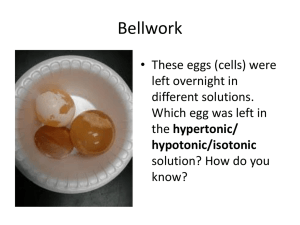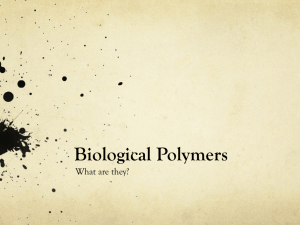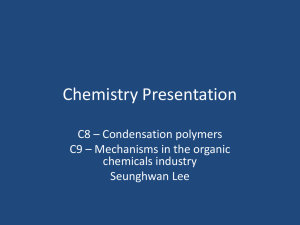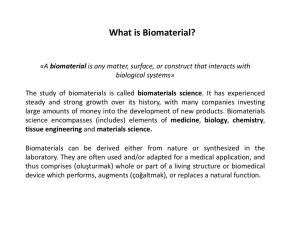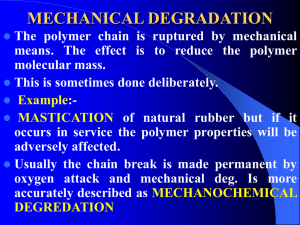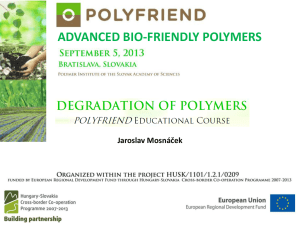POLYMERS
advertisement
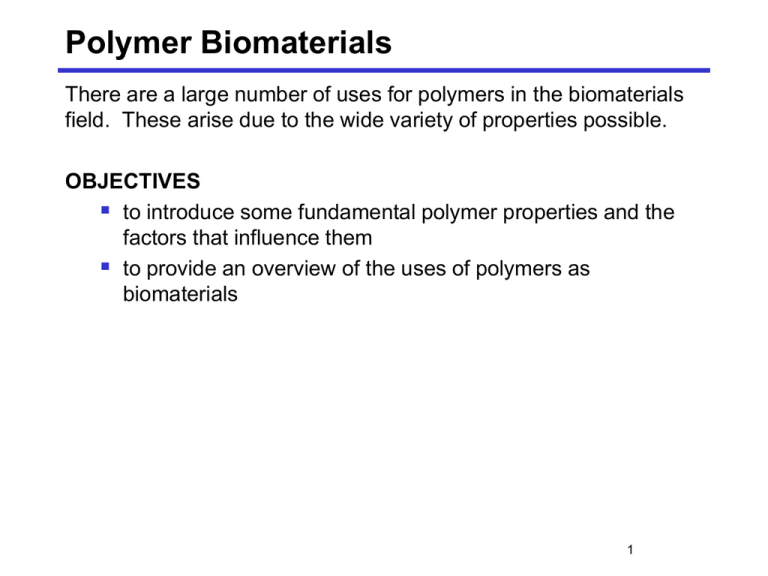
Polymer Biomaterials There are a large number of uses for polymers in the biomaterials field. These arise due to the wide variety of properties possible. OBJECTIVES to introduce some fundamental polymer properties and the factors that influence them to provide an overview of the uses of polymers as biomaterials 1 POLYMERS Polymers - long chain molecules of high molecular weight -(CH2)nUse State n 1-4 gas burned for energy 5-11 liquid gasoline 9-16 med. visc. liquid kerosene 16-25 hi visc. liq. oil, grease 25-50 solid paraffin wax 10003000 tough plastic PE bottles, containers 2 Common Polymer Biomaterials 3 Polymers In Specific Applications application properties and design requirements polymers used dental •stability and corrosion resistance, plasticity •strength and fatigue resistance, coating activity •good adhesion/integration with tissue •low allergenicity PMMA-based resins for fillings/prosthesis polyamides poly(Zn acrylates) ophthalmic •gel or film forming ability, hydrophilicity •oxygen permeability polyacrylamide gels PHEMA and copolymers orthopedic •strength and resistance to mechanical restraints and fatigue •good integration with bones and muscles PE, PMMA PL, PG, PLG cardiovascular •fatigue resistance, lubricity, sterilizability •lack of thrombus, emboli formation •lack of chronic inflammatory response silicones, Teflon, poly(urethanes), PEO drug delivery •appropriate drug release profile •compatibility with drug, biodegradability PLG, EVA, silicones, HEMA, PCPP-SA sutures •good tensile strength, strength retention •flexibility, knot retention, low tissue drag silk, catgut, PLG, PTMC-G PP, nylon,PB-TE 4 Properties: Molecular weight synthetic polymers possess a molecular weight distribution Ni Mi åN M = åN M i Mw 2 i i i åN M = åN i i Mn i i i dispersity index = Mw/Mn i i 5 The Bulk State : Solid Polymers can be either amorphous or semi-crystalline, or can exist in a glassy state. amorphous glassy state hard, brittle no melting point semi-crystalline glassy state hard, brittle crystal formation when cooled exhibit a melting point Glass transition temperature (Tg) 6 Thermal Behavior semi-crystalline Rubber Liquid Viscous Liquid Tm tough plastic T Tg semi-crystalline plastic crystalline solid 10 1000 100000 1000000 molecular weight (g/mol) 7 Crosslinked Networks crosslinks covalent; H-bonding; entanglements crosslinking increased molecular weight swell in solvents • organogel • hydrogel 8 Thermal Properties Polymer Tg (ºC) Tm (ºC) Nylon 6,6 45 267 UHMWPE -125 140 Silicone -123 -29 poly(urethane) 0-90 125-225 poly(methylmethacrylate) 105 160 poly(D,L-lactide) 50 amorphous poly(-caprolactone) - 60 57 poly(glycolic acid) 35 210 9 Viscoelasticity Stress The response of polymeric materials to an imposed stress may under certain conditions resemble the behavior of a solid or a liquid. Strain 10 Mechanical Properties 11 Diffusion in Polymers Polymers can also act as solvents for low molecular weight compounds. The diffusion of small molecular weight components in polymers is important in a number of fields : purification of gases by membrane separation dialysis prevention of moisture loss in food and drugs (packaging) controlled drug delivery (transdermal patches, Ocusert) polymer degradation 12 Diffusion in Polymers Flux is dependent on : solubility of component in polymer diffusivity of component in polymer These in turn depend on : nature of polymer temperature nature of component interaction of component with polymer 13 Solubility Estimation From Hildebrand, the interaction parameter, c, is defined as : V1(d1 - d 2 ) c= RT 2 The solubility parameter, d, reflects the cohesive energy density of a material, or the energy of vapourization per unit volume. While a precise prediction of solubility requires an exact knowledge of the Gibbs energy of mixing, solubility parameters are frequently used as a rough estimator. In general, a polymer will dissolve a given solute if the absolute value of the difference in d between the materials is less than 1 (cal/cm3)1/2. 14 Diffusivity experimental observations effect of T vs Tg 15 Diffusivity effect of permeant size 16 Diffusivity : Effect of Crystallinity solutes do not penetrate crystals readily take path of least resistance • through amorphous regions increased path length D1,c æ 1-f ö = D1,a ç f c ÷ ç 1+ c ÷ è xø D1,c = diffusivity in semi-crystalline polymer D1,a = diffusivity in amorphous polymer fc = volume fraction of crystals x = shape factor (=2 for spheres) (Mathematics of Diffusion) 17 Example of Undesirable Absorption poppet-style heart valve • poppet is composed of PDMS • in small % of patients the poppet jammed or escaped • recovered poppets were yellow, smelled, and had strut grooves 18 Leaching - Undesirable polymers often contain contaminants as a result of their synthesis/manufacturing procedure/equipment may also contain plasticizers, antioxidants and so on these contaminants are a frequent cause of a polymer’s observed incompatibility 19 Drug Delivery Ocusert TD - Scopolamine 20 In Vivo Degradation of Polymers no polymer is impervious to chemical and physical actions of the body Mechanisms causing degradation Physical Chemical sorption/swelling hydrolysis softening oxidation dissolution enzymatic stress cracking fatigue cracking 21 Hydrolytic Degradation hydrolysis the scission of chemical functional groups by reaction with water there are a variety of hydrolyzable polymeric materials: esters amides anhydrides carbonates urethanes 22 Hydrolytic Degradation degradation rate dependent on hydrophobicity crystallinity Tg impurities initial molecular weight, polydispersity degree of crosslinking manufacturing procedure geometry site of implantation 23 Hydrolytic Degradation bulk erosion (homogeneous) uniform degradation throughout polymer process random hydrolytic cleavage (auto-catalytic) diffusion of oligomers and fragmentation of device surface erosion (heterogeneous) polymer degrades only at polymer-water interface 24 Polyesters fractional change in molecular weight Polyesters 26 Oxidative Degradation usually involves the abstraction of an H to yield an ion or a radical direct oxidation by host and/or device • release of superoxide anion and hydrogen peroxide by neutrophils and macrophages • catalyzed by presence of metal ions from corrosion 27 Poly(Carbonates) PEC in vivo M. Acemoglu, In. J. Pharm. 277 (2004) 133-139 28 Enzymatic Degradation Natural polymers degrade primarily via enzyme action collagen by collagenases, lysozyme glycosaminoglycans by hyaluronidase, lysozyme There is also evidence that degradation of synthetic polymers is due to or enhanced by enzymes. Z Gan et al., Polymer 40 (1999) 2859 C.G. Pitt et al., J. Control. Rel. 1(1984) 3-14 29

